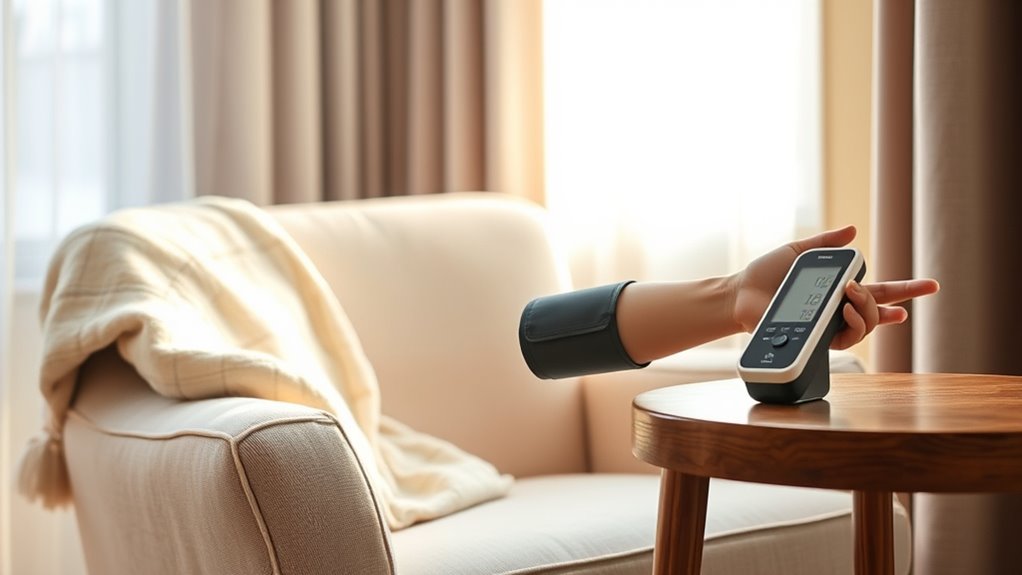To effectively monitor your blood pressure at home, choose a validated device and guarantee the cuff fits properly. Prepare by resting for five minutes, sitting upright with your arm at heart level, and avoiding caffeine or smoking beforehand. Take multiple measurements over time to spot trends, and record your results with date and notes. Proper technique and regular calibration are key for accuracy. Keep learning to master these steps and stay on top of your heart health.
Key Takeaways
- Choose a validated automatic upper-arm monitor with proper cuff size for accurate readings.
- Prepare by resting quietly for 5 minutes and avoiding caffeine or smoking 30 minutes before measuring.
- Sit with back supported, feet flat, and arm at heart level, supporting the arm on a flat surface.
- Take multiple readings over several days to identify patterns rather than relying on a single measurement.
- Log and review your blood pressure readings regularly to monitor trends and discuss concerns with your healthcare provider.
Understanding Blood Pressure and Why It Matters
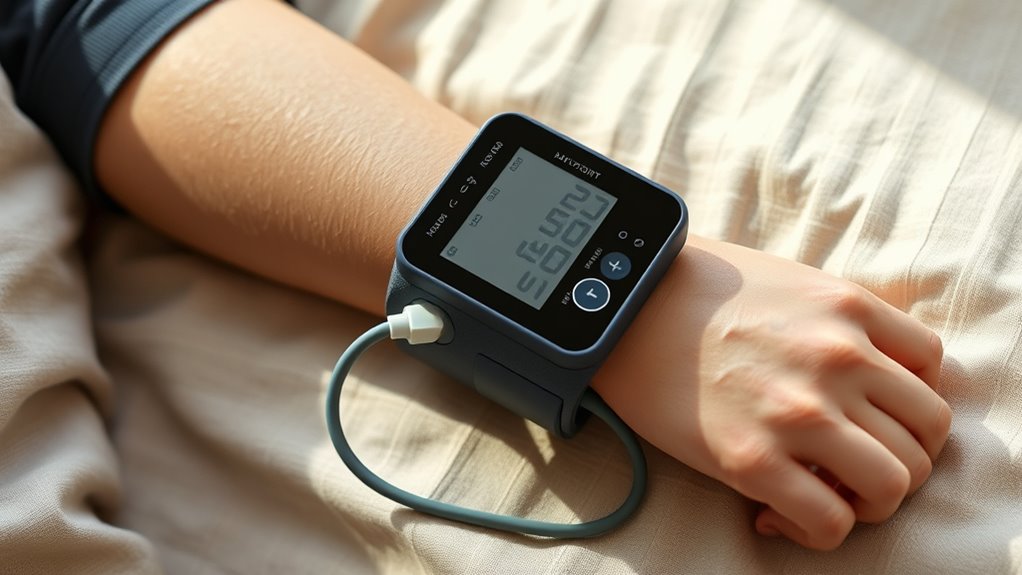
Understanding blood pressure is essential because it indicates how hard your blood pushes against your artery walls as your heart beats and rests. Many blood pressure myths can lead you to misunderstand its significance, but knowing the facts helps you stay proactive. High blood pressure, or hypertension, often has no obvious symptoms, so monitoring it regularly is key for prevention. By keeping an eye on your numbers, you can catch potential issues early and take steps to lower your risk. Hypertension prevention involves lifestyle changes like healthy eating, exercising, and managing stress, which all influence your blood pressure. Don’t fall for myths that downplay its importance; understanding your blood pressure empowers you to maintain heart health and avoid serious complications. Regular blood pressure monitoring is crucial, especially since high blood pressure can be asymptomatic and go unnoticed without consistent checks.
Choosing the Right Blood Pressure Monitor

Selecting the right blood pressure monitor is essential because accurate readings depend on choosing a device suited to your needs. First, focus on device accuracy; look for monitors validated by reputable organizations to ensure reliable results. Next, consider cuff size selection—using the correct cuff size is critical for precise measurements. A cuff that’s too small or too large can give false readings, so measure your arm to find the right fit. Automatic upper-arm monitors are generally easier to use and more accurate than wrist or finger models. Also, check for features like memory storage and user prompts that suit your lifestyle. Proper cuff size is vital because an ill-fitting cuff can compromise measurement accuracy. By prioritizing device accuracy and proper cuff size, you set yourself up for consistent, trustworthy blood pressure readings at home.
Preparing for Your Blood Pressure Reading

Before taking your blood pressure, sit quietly for a few minutes to rest. Avoid caffeine or smoking at least 30 minutes before your reading, as they can affect your results. Make sure you’re sitting upright with your back supported and your arm at heart level for an accurate measurement. Ensuring proper device calibration can also help in obtaining reliable readings.
Rest Before Measuring
To get an accurate blood pressure reading, you should rest quietly for at least five minutes beforehand. This rest period allows your body to stabilize, giving a more reliable measurement. During this time, focus on relaxation techniques such as deep breathing or gentle stretching. To make the most of your rest, consider these tips:
- Sit comfortably with your back supported and feet flat on the floor.
- Keep your arm supported at heart level.
- Avoid talking or moving during the rest period.
- Take slow, deep breaths to help relax your muscles and mind.
- Being mindful of automation’s role in health monitoring can further enhance your understanding and consistency in home blood pressure tracking.
Following these steps ensures your body is calm, reducing stress factors that could skew your reading. Proper rest and relaxation techniques are key to accurate home blood pressure monitoring.
Avoid Caffeine Intake
Have you recently consumed caffeine? Caffeine effects can temporarily raise your blood pressure, making your reading less accurate. To get the most reliable results, avoid caffeine at least 30 minutes before measuring your blood pressure. Be mindful of beverage timing; even a small coffee or tea can influence your readings. If you’ve had caffeine earlier in the day, wait a few hours before testing. Remember, caffeine stimulates your nervous system, which can cause a spike in blood pressure that doesn’t reflect your usual levels. Eliminating caffeine prior to measurement helps guarantee your reading accurately reflects your baseline blood pressure. Staying consistent with caffeine intake before readings ensures more reliable tracking of your blood pressure over time. Additionally, Vetted – 1st Home Theatre Projector can provide guidance on creating a calm environment, which is also beneficial for obtaining accurate blood pressure readings.
Sit Properly During Reading
Properly sitting during your blood pressure measurement helps guarantee the reading is accurate. To ensure proper posture and arm positioning, follow these steps:
- Sit with your back straight and supported by a chair, feet flat on the floor.
- Rest your arm on a flat surface, like a table, so your upper arm is at heart level.
- Keep your legs uncrossed to maintain proper circulation.
- Relax for a few minutes before taking your reading, avoiding talking or moving.
- Avoid forsale 100 items or distractions that could influence your focus and relaxation during the measurement.
Maintaining proper posture and correct arm positioning reduces measurement errors and gives you the most reliable results. Focus on staying still and calm during the process to ensure consistency and accuracy in your blood pressure readings.
How to Properly Position Yourself During Measurement
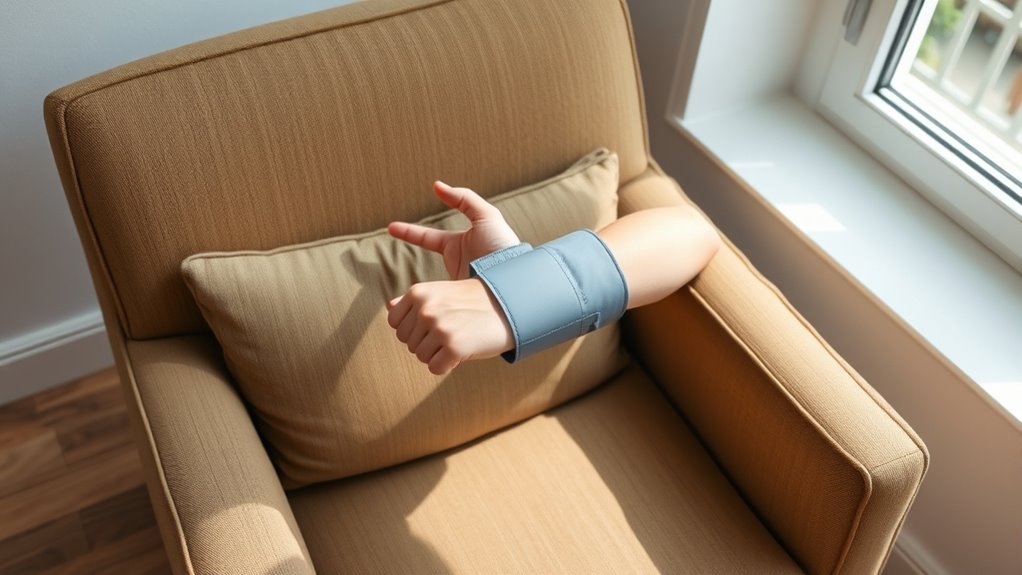
Ensuring you’re seated correctly is essential for an accurate blood pressure reading. Start by sitting with your back straight and supported, and keep your feet flat on the floor. Your sitting posture should be relaxed but alert. When it comes to arm placement, rest your arm on a table or flat surface at heart level. Make sure your arm is slightly bent and supported, avoiding any tension. Keep your palm facing upward and the cuff positioned snugly around your upper arm, about an inch above the elbow. Avoid crossing your legs or leaning back, as these can affect the reading. Proper arm placement and sitting posture help ensure your blood pressure measurement reflects your true levels accurately. Paying attention to your body positioning during measurement can significantly improve the accuracy of your readings.
Step-by-Step Guide to Taking Your Blood Pressure
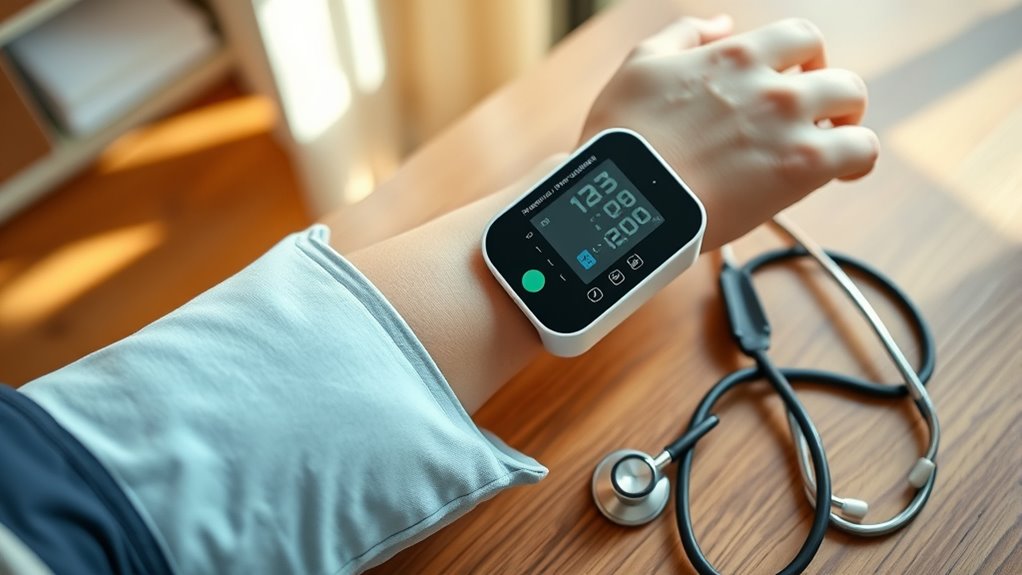
To get accurate readings, start by preparing your equipment and ensuring your cuff is in good condition. Next, position your arm correctly at heart level to avoid errors, and then take your measurement. Proper device placement is crucial for reliable results. Finally, record and track your results to monitor your blood pressure over time.
Prepare Your Equipment
Before you start measuring your blood pressure, gather all the necessary equipment to guarantee a smooth process. First, ensure your monitor is properly calibrated; check the calibration frequency recommended by the manufacturer—usually once every 1-2 years. Second, select the correct cuff size; a cuff that’s too small or too large can produce inaccurate readings. Third, have fresh batteries ready if your device is battery-operated. Fourth, keep a clean, flat surface nearby to place your monitor on. Confirm that the cuff fits snugly around your upper arm without being too tight or loose. Proper preparation of your equipment helps ensure accurate, reliable readings and makes the process faster and easier. Additionally, understanding the importance of monitor calibration can help maintain the device’s accuracy over time.
Properly Position Arm
Proper arm positioning is essential for accurate blood pressure readings. To get reliable results, make sure your arm is at heart level, supported, and relaxed. Sit comfortably with your back straight and feet flat on the floor. Rest your arm on a table or armrest, keeping it steady. When placing the cuff, ensure it’s snug but not too tight, with the cuff’s bottom edge about an inch above your elbow. Proper cuff placement over the brachial artery is critical. Use the table below to check your positioning:
| Arm Positioning | Cuff Placement |
|---|---|
| Support your arm at heart level | Cuff snug around upper arm |
| Keep your arm relaxed | Center cuff over brachial artery |
| Sit with feet flat, back straight | Ensure cuff covers artery adequately |
Additionally, maintaining a consistent measurement environment can help improve the accuracy of your blood pressure readings.
Record and Track Results
Once you’ve taken your blood pressure, it’s important to record and track your results accurately. Using digital tracking tools simplifies this process and makes data visualization easier. Here’s how to do it effectively:
- Log each reading immediately in your digital app or journal to avoid forgetfulness.
- Note the date and time to identify patterns over specific periods.
- Include any relevant notes like how you felt or recent activities.
- Review your data regularly to observe trends and share insights with your healthcare provider.
Consistent recording helps you see your blood pressure trends clearly. Digital tools make tracking straightforward, enabling you to visualize fluctuations over days or weeks. This organized approach empowers you to manage your health proactively.
Recording and Tracking Your Readings
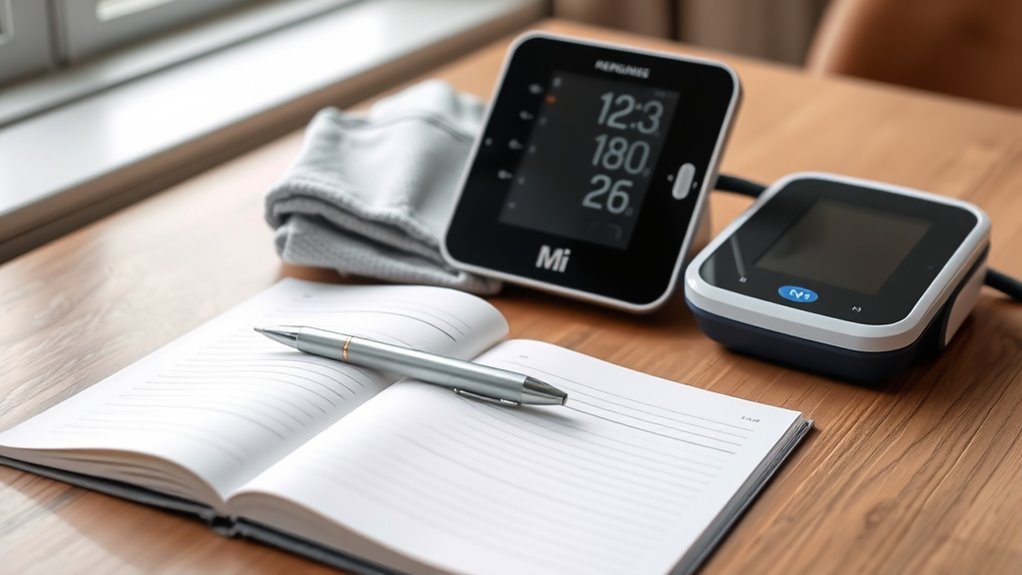
Keeping an accurate record of your blood pressure readings is essential for managing your health. Data logging helps you track patterns over time, making it easier to identify trends. Use a dedicated notebook or digital app to record each measurement immediately after testing. Include the date, time, and reading details to stay organized. To simplify tracking, consider this example:
| Date | Time | Systolic/Diastolic |
|---|---|---|
| 2024-04-20 | 8:00 AM | 120/80 |
| 2024-04-21 | 8:00 AM | 118/78 |
| 2024-04-22 | 8:00 AM | 122/81 |
Regularly reviewing your logs enables trend analysis, helping you and your healthcare provider make informed decisions about your blood pressure management.
Interpreting Your Blood Pressure Results
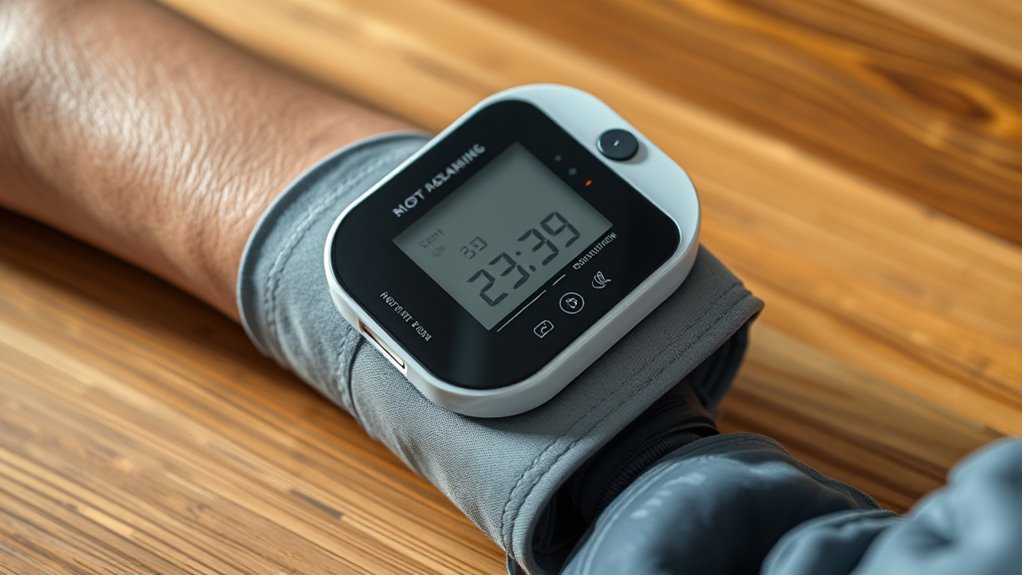
Understanding what your blood pressure readings mean is key to managing your health effectively. Blood pressure fluctuations are normal, but consistent readings help you identify patterns. To interpret your results accurately, consider these points:
Monitoring consistent blood pressure readings helps identify health patterns effectively.
- Check if your readings fall within the normal range of around 120/80 mm Hg.
- Remember that readings above 130/80 mm Hg may indicate hypertension.
- Be aware that factors like stress, activity, or incorrect cuff placement can affect reading accuracy.
- Look for patterns over multiple days rather than focusing on a single measurement.
Common Mistakes to Avoid
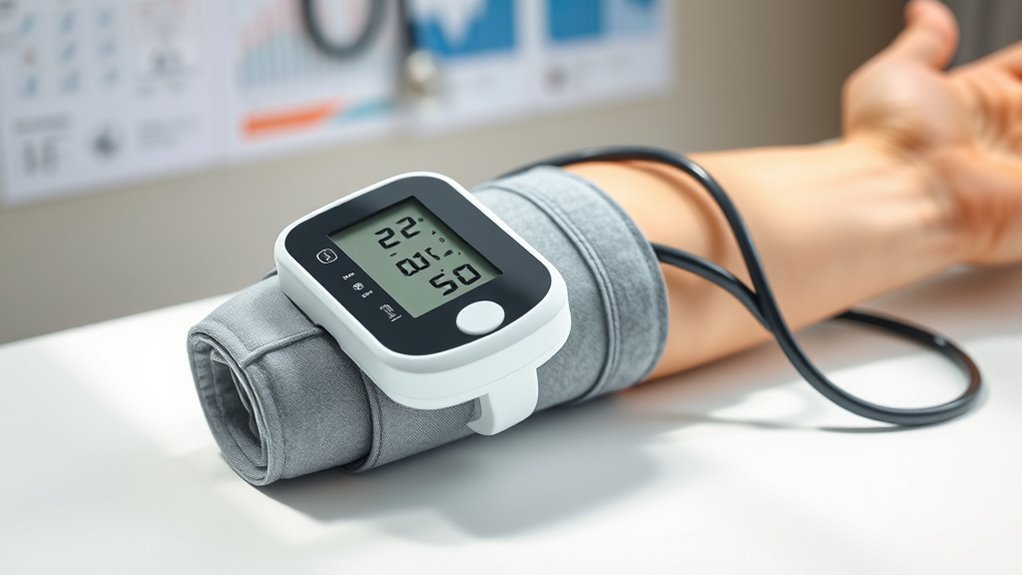
When monitoring your blood pressure at home, it’s easy to make mistakes that can lead to inaccurate readings and misinterpretations. One common mistake is using a cuff that’s too small or too large, which can cause readings to be falsely high or low. Always choose a cuff that fits your arm properly. Calibration errors also pose a problem; if your device isn’t calibrated correctly, your readings won’t be reliable. Regularly check your monitor’s accuracy according to the manufacturer’s instructions. Additionally, avoid taking readings immediately after exercise, caffeine, or smoking, as these can skew results. Make sure to sit quietly for a few minutes before measuring and follow proper technique to ensure consistency. Paying attention to these details helps you get accurate, useful blood pressure readings at home.
When to Consult Your Healthcare Provider
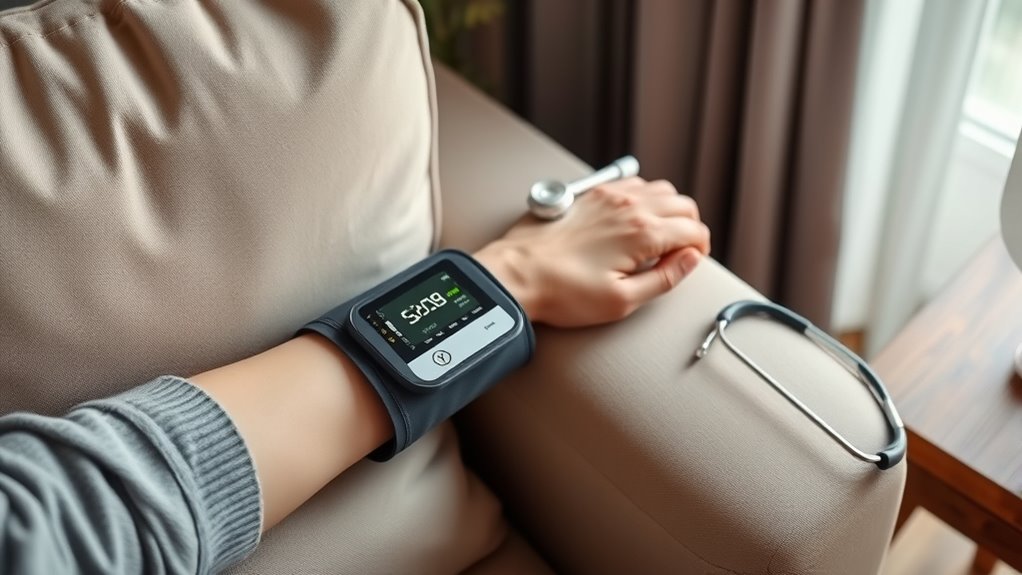
It’s important to contact your healthcare provider if you notice consistently high or low blood pressure readings, especially if they remain unchanged despite adjustments or lifestyle changes. Pay attention to symptom awareness, such as dizziness, headaches, or chest pain, which could signal a problem. Also, monitor medication effects, as some drugs may influence your readings or cause side effects. Consider reaching out if:
- Your readings are above 140/90 mm Hg regularly
- Your readings drop below 90/60 mm Hg unexpectedly
- You experience symptoms like shortness of breath or vision changes
- You notice unusual side effects from medications affecting your blood pressure
Prompt consultation ensures proper management and prevents complications. Don’t overlook persistent changes—your health depends on it.
Tips for Maintaining Consistent Monitoring
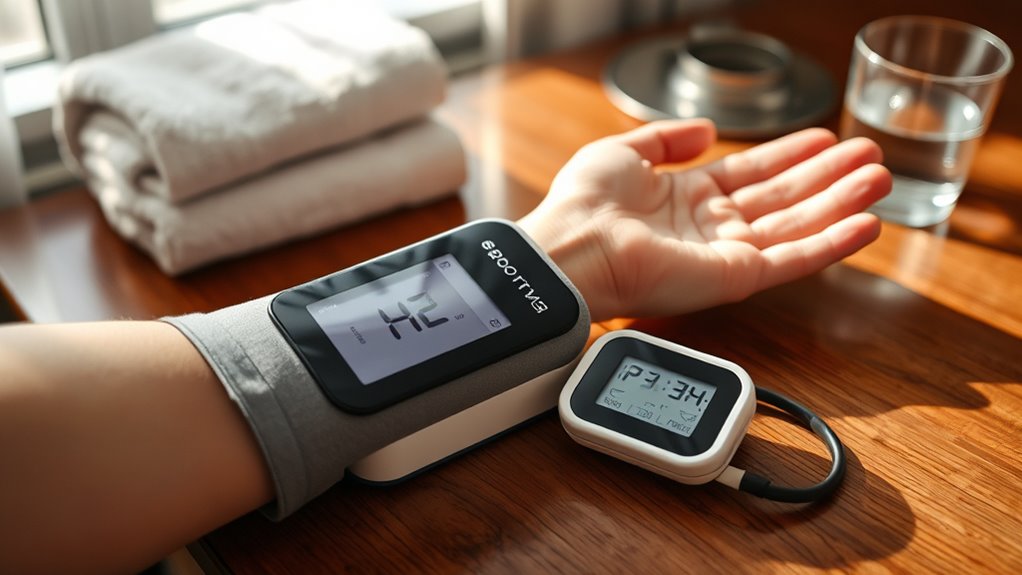
To guarantee accurate blood pressure readings, establishing a routine for monitoring is essential. Consistency helps you track trends and detect changes promptly. Incorporate tech innovations like automatic monitors with memory functions to simplify tracking. Lifestyle adjustments, such as measuring at the same time daily and avoiding caffeine or exercise beforehand, improve accuracy. Set reminders on your phone or device to stay on schedule. Use the table below to understand key factors influencing consistency:
| Factor | Impact |
|---|---|
| Tech innovations | Enhance ease and precision of readings |
| Lifestyle adjustments | Create predictable routines |
| Regular schedule | Ensures comparable results |
| Proper positioning | Maintains measurement accuracy |
Sticking to these tips helps you maintain reliable monitoring habits.
Frequently Asked Questions
How Often Should I Check My Blood Pressure at Home?
You should check your blood pressure at home at least once a day, ideally at the same time each day, to monitor your health effectively. This helps guarantee monitoring accuracy and catch any changes early. Be sure your device is properly calibrated and functioning well, as inaccurate readings can lead to misinterpretation. Regular checks give you a clear picture of your blood pressure trends and help your healthcare provider make informed decisions.
Can Stress Affect My Home Blood Pressure Readings?
Stress can definitely throw a wrench in your blood pressure readings. When you’re emotional or anxious, your body releases hormones that temporarily raise your blood pressure, making it seem like your numbers are higher than they actually are. This stress impact can lead you to believe you have hypertension when you don’t. To get accurate results, try to stay calm and relaxed during your readings, keeping emotional factors in check.
What Should I Do if My Readings Are Consistently High?
If your readings are consistently high, don’t ignore them. You should consult your healthcare provider to discuss possible causes and next steps. Meanwhile, make lifestyle adjustments like reducing salt intake, exercising regularly, and managing stress. Confirm medication adherence if prescribed. These actions can help lower your blood pressure and improve your overall health, but professional guidance is essential for developing a tailored plan.
Are There Specific Times of Day Best for Monitoring?
Did you know that blood pressure varies throughout the day, with readings usually lower at night and higher during the day? To get accurate measurements, pick consistent times of day, like morning and evening, and adhere to them. This helps track trends over time and guarantees measurement consistency. Monitoring at the same times daily gives you a clearer picture of your blood pressure, making it easier to manage your health effectively.
How Do Different Medications Impact Home Blood Pressure Readings?
Different medications can markedly impact your blood pressure readings. Some drugs, like diuretics or beta-blockers, lower blood pressure, while others, such as certain antidepressants or NSAIDs, may raise it. Be aware of medication side effects and potential drug interactions that could skew your readings. Always monitor consistently, and discuss any changes or unusual results with your healthcare provider to guarantee your medication plan is effective and safe.
Conclusion
By mastering home blood pressure monitoring, you hold the key to your health’s compass. Think of each reading as a beacon guiding you through the fog, helping you navigate towards better well-being. Stay consistent, stay vigilant, and remember—your proactive steps today can illuminate a healthier tomorrow. Embrace this knowledge as your trusted lighthouse, steering you clear of unseen dangers and toward a future where your heart’s rhythm beats strong and steady.
